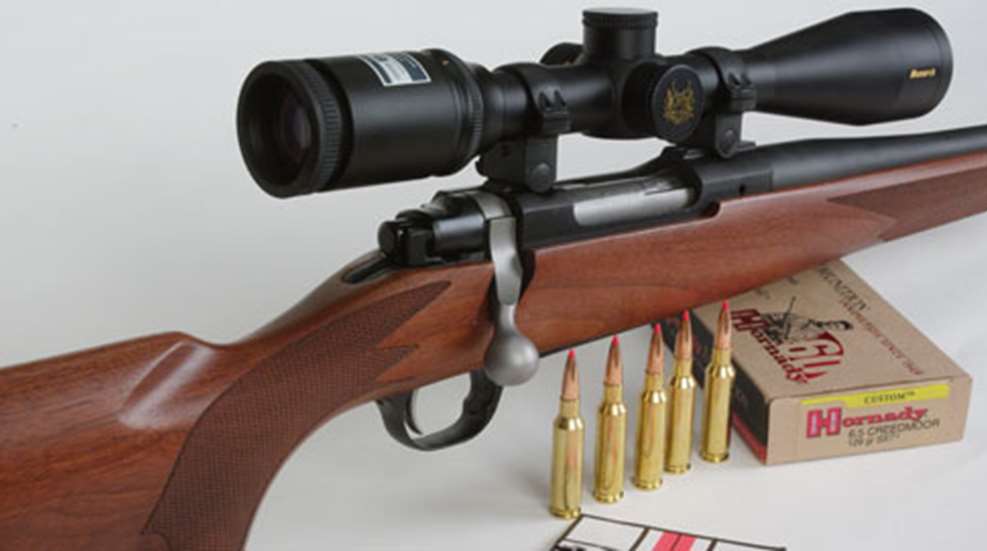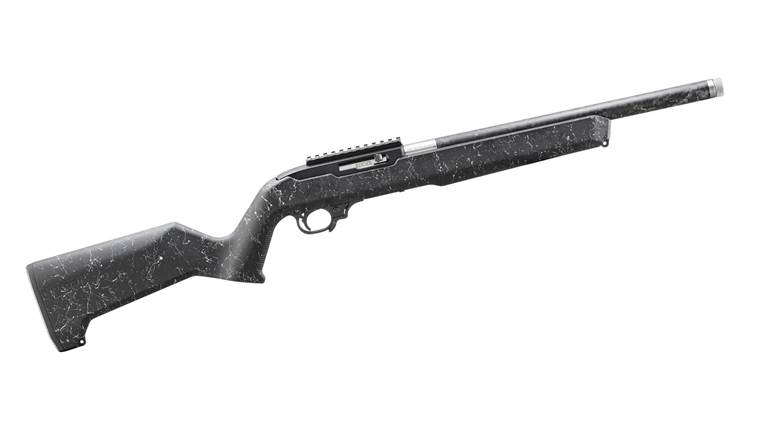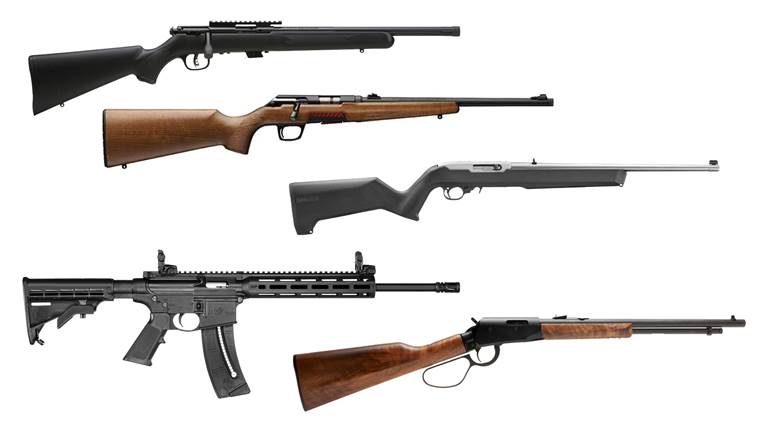
During the 2007 Camp Perry matches, Hornady engineer Dave Emary and High Power National Champion Dennis DeMille were talking about the 6.5 wildcat cartridges that are popular in the sport. They thought it would be great if there was a cartridge that followed current popular design, was accurate enough to win and was available from a commercial ammo manufacturer. So Emary and fellow Hornady engineer, Joe Thielen pooled their talents and in 2008 announced a new Hornady cartridge designed for long-range shooting called the 6.5 Creedmoor.
The 6.5 Creedmoor can trace its roots back to an odd parentage—one far from the long-range target game. The .307 Winchester was introduced in 1982 and was designed for the lever-action Winchester Model 94 rifle. The case was later used as the basis for the .30 TC, which was introduced in 2007. The case was shortened, the walls thinned and the rim removed. When the resulting .30 TC was necked down to take a 0.264-inch bullet, the 6.5 Creedmoor was born.
Emary said the cartridge was designed around the 140-grain A-Max bullet preferred by long-range target shooters. They looked at other short-action 0.264-inch cartridges and made some changes to the chamber throat angle and other specifications to accommodate a long ogive, high-ballistic-coefficient bullet of that weight.
The 6.5 Creedmoor cartridge has a 0.473-inch-diameter case head, the same as the .30-06 family of cartridges. It has a 30-degree shoulder, and the case length is 1.920 inches. The overall cartridge length is 2.825 inches, so it will fit in a standard short action. With a difference of almost a full inch between the case length and the overall cartridge length, there is plenty of room for the long 140-grain 6.5 mm, VLD-type bullets to extend from the case, so they can be seated properly without intruding into the powder space. The listed muzzle velocity for the 140-grain load is 2,710 fps. This matches MV almost exactly with .260 Rem. with the same bullet weight, even though the .260 Rem. is a larger case.
David Tubb soon chambered rifles for the cartridge, and DPMS offered it in their Panther 6.5 AR-10 style rifle.
Although the 6.5 Creedmoor was designed as a target cartridge, it quickly became apparent that it would also make an excellent hunting cartridge. With that in mind, Hornady introduced a load with their 129-grain SST bullet. This SST load was one of the first Superformance loads developed. In fact, my sample made no mention of that as the Superformance line was still a few months away from being announced when the samples arrived here for testing. The added velocity came as a surprise while testing the cartridge. The listed velocity for the 129-grain SST load is 2,950 fps. This is considerably faster than the 140-grain load; however, its 129-grain SST bullet gives up a full point in ballistic coefficient to the 140-grain A-Max; 0.485 for the SST versus 0.585 for the A-Max. But, 0.485 is still respectable. With a 200-yard zero the 129-grain SST bullet’s path will be 1.54 inches high at 100 yards; 6.81 inches low at 300 yards and 19.70 inches below the line of sight at 400 yards. It still has 1,000 ft.-lbs. of energy remaining at 600 yards.
Hornady also offers this cartridge with a 120-grain GMX bullet in the Superformance line and lists the muzzle velocity at 3,010 fps.
To mate with the new SST hunting ammo, last year Ruger introduced the 6.5 Creedmoor cartridge in its Hawkeye Standard model rifle with a 26-inch barrel. This trim, lightweight sporter made a good match with the hunting aspect of the cartridge. I tested the new SST load and the new rifle built for it together as a package.
The 6.5 Creedmoor load uses an average of 44.74 grains of propellant. Hornady has worked with suppliers to develop propellants that have a more progressive burn rate. They used physical changes in the propellant granules, combined with new chemical coatings that control the rate of burn. By slowing the progression of rate of burn, they change the shape of the pressure curves. Conventional propellants produce a quick spike in pressure, with a sharp peak followed by a quick drop off. The new propellants produce a more gradual curve with a softer, more rounded peak. That means that the average amount of pressure pushing against the bullet during its travel from chamber to muzzle is higher than with conventional propellants. Muzzle velocity is increased without any increase in peak pressure.
The Hawkeye rifle is a basic, wood stock, blued metal model. The bolt is matte-finished stainless steel. The rifle features the LC6 trigger, and our sample broke cleanly at 4 pounds, 10 ounces. The barrel is 26-inches long and has a thin “sporter” contour that measures just 0.640 inches at the muzzle.
The two-lug bolt has a non-rotating, Mauser-type controlled-round-feed extractor. However, more than half of the time during my test, the rifle did not pick up the cartridges from the magazine and capture them behind the extractor. It became, in effect, a push feed as the extractor did not capture the case until the bolt was closed.
The rifle features a steel drop-style floorplate to empty the box magazine. The three-position safety locks the bolt shut and on safe when in the back position. The center position is still safe, but allows the bolt to open. The forward position is fire. As with all Ruger three-position safeties, it’s a bit small and hard to operate while wearing gloves. The rifle has integral scope mounts machined into the receiver and ships with rings included. For the shooting test I mounted a Nikon 4-16X 42 mm SF scope.
The walnut stock has a thin, red rubber butt pad with the Ruger logo on it. It also has a contoured, plastic grip cap covering the pistol grip. Inside the grip cap is an oval, ivory inlay with the Ruger logo etched in black.
I was able to take the Ruger afield on several excursions and was pleased with its easy-handling and soft-shooting qualities. The 6.5 Creedmoor proved to be very accurate. I tested the original 140-grain A-Max target load as a baseline and the results were impressive. Five, 5-shot 100-yard groups averaged 0.94 inches. The SST load was not far behind with an average of 1.12 inches. This is a particularly good result from a thin-barreled hunting rifle.
While it duplicates the ballistics of the well-established .260 Rem., this cartridge does bring a bit more to the table. Its legacy of accuracy is well-founded, the recoil is mild, and as cartridges go, it is certainly different. It is designed to work better than its green cousin with the long 140-grain high BC bullets, which are finding some favor with hunters. The 6.5 Creedmoor is designed for target shooting, but with this new load it should find a fan club of deer and antelope hunters carrying it to the fields each year.
Manufacturer: Sturm, Ruger & Co.; (603) 865-2442; www.ruger.com.
Caliber: 6.5 Creedmoor
Action Type: bolt-action
Receiver: short-action
Barrel Length: 26”
Rifling: 1:8” RH Twist
Magazine: internal, drop-out floorplate; four-round-capacity
Sights: no sights; scope rings included
Trigger Pull: 4 lbs., 10 ozs.
Stock: walnut
Overall Length: 46”
Weight: 7 lbs
Accessories: scope rings, owner’s manual
Suggested Retail Price: $827





































